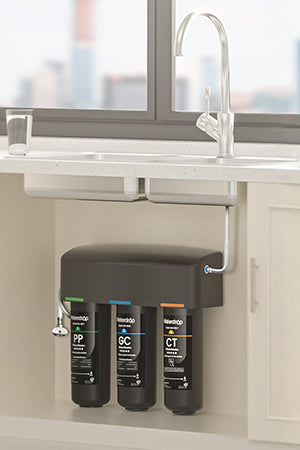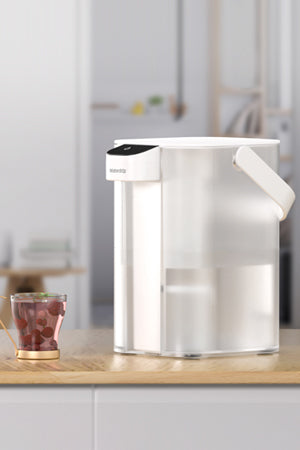The last thing on your mind when filling a glass of water from the tap may be what kind of chemicals it contains. The fact is that water from most water supplies around the world, including Singapore, contains chlorine that helps to clean it for drinking. Although it's an important factor in water quality, it may be a good idea to consider what kind of consequences it may have on your health as well as the taste of your water.
In this tutorial, we'll discuss the role of chlorine in tap water, the rationales behind using it in the water system in Singapore, the consequences that may arise from consuming it, and finally describe methods of reducing it using a Waterdrop water filter.
What is Chlorine and Why is it Added to Tap Water?
Chlorine is a chemical used to eliminate harmful bacteria and viruses from water. The chemical's ability to eliminate bacteria and viruses has made it widely used as a treatment process for water. As a matter of fact, chlorine is added to water to ensure that it's free from harmful organisms that may cause an individual to fall sick.
In Singapore, it is
the Public Utilities Board (PUB) that regulates the treatment and distribution of clean tap water. The water goes through a robust process that entails using chlorine, as well as other disinfectants such as chloramine. All these ensure that your tap water remains free from disease-causing organisms.
While chlorine is effective in purifying water, its presence in tap water can have both beneficial and negative effects, which is why understanding how it affects your health is crucial.
How Does Chlorine Affect the Taste and Smell of Tap Water?
If you have ever observed that your tap water has that distinct chlorine smell or taste, it may be due to the chlorine content. Although chlorine is important to ensure that the water that you drink is clean and fresh, it may greatly affect the smell of the water. The concentration of chlorine in your tap water may change depending on either the treatment process of the water or the water itself that comes from your sources.
The taste of chlorine in your water may be quite irritating if it's used for both drinking and cooking. Given that it has a very strong smell due to the chlorine content, it may alter the taste of your water.
Is Chlorine in Tap Water Harmful?
When used at the prescribed concentration, chlorine is known to be harmless. In order to avoid posing threats to human as well as environmental health, the
WHO and
EPA have prescribed certain levels of chlorine that should be present within drinking water. In the context of Singapore, it can be noted that it maintains prescribed levels of chlorine in the water.
However, exposure to chlorine at higher concentration levels may pose certain health-related problems. These include:
-
Skin and eye irritation: The skin and eyes may become irritated by chlorine. For example, for persons with sensitive skin, the eyes may become itchy or dry as a result of exposure to chlorine.
-
Respiratory issues: Inhaling high levels of chlorine gas may trigger respiratory ailments such as coughing or wheezing.
-
Digestive Discomfort: Although the concentration of chlorine in drinking water is relatively low, it may irritate the digestive system if high concentrations of water containing chlorine are continuously consumed.
Moreover, chlorine may also react with organic matter that is found in water. As a result of such reactions, harmful by-products called trihalomethanes may form. High-level exposure to these by-products has been known to pose various kinds of threats to human health, including cancer. In addition, the levels of these by-products in the tap water of Singapore remain strictly controlled.
How to Reduce Chlorine in Tap Water?
Although chlorine is added to water for various purposes like purification and decontamination of water before it can be used as drinkable water, some persons may want to remove it from the water. In your case, since you may want to remove chlorine from your water, I'll list some of the techniques used in the removal of chlorine.
1. Let Your Water Sit
The easiest technique that you could implement to decrease the levels of chlorine found in your tap water may be letting it sit for an interval. The thing about chlorine is that it's quite volatile. That's why it starts to evaporate as it comes into contact with the atmosphere. The only problem with this technique is that it won't work on chloramine. It's another water disinfecting agent that's commonly used.
2. Use Activated Carbon Filters
Another commonly used technique to remove chlorine from tap water is by using filters that contain activated carbon. The activated carbon filter has the ability to remove chlorine and pesticides from water by adsorption. This increases the taste and odor of the water. Many water filters come with activated carbon.
Activated carbon filters work less well against larger pollutants like heavy metals and bacteria. If you want a more robust filtrate solution, perhaps a
Reverse Osmosis system may work for you.
How Waterdrop Water Filters Can Help You Remove Chlorine
Waterdrop provides various types of water filtration options that not only remove chlorine from your tap water but also protect your water from various contaminants such as heavy metals, chlorine by-products, and bacteria. The water filters from Waterdrop remove chlorine from your water by using reverse osmosis and multiple-stage water filtration technologies that ensure your water not only lacks chlorine but also tastes clean and fresh.
People Also Ask
Why should chlorine be added to tap water?
Chlorine is used in tap water as a disinfectant and killer of harmful organisms such as bacteria, viruses, and parasites. The water you get from your tap is therefore clean.
Can chlorine in drinking water be harmful?
The concentration of chlorine used in tap water is relatively safe. Exposing the body to high concentrations of chlorine or by-products may pose health concerns such as skin irritation, respiratory problems, or digestive difficulties.
How can I remove chlorine from my tap water?
The chlorine content of your tap water can be reduced by using a reverse osmosis system, an activated carbon filter, or simply by letting the water sit for a few hours to let the chlorine evaporate.
Summary
Chlorine is an important component that helps ensure the tap water that flows through your house remains clean by eliminating harmful bacteria. The component may also have an influence on the taste and quality of your water.
If you feel that chlorine may be an issue with your water that you consume on a daily basis, it may be important to invest in a
Waterdrop RO water filter . Using reverse osmosis technology, multi-stage filtration, and intelligent designs, Waterdrop provides the ultimate solutions for getting rid of chlorine and various pollutants from your tap water.



































































